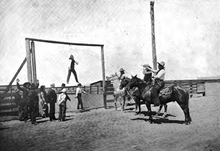- Capital punishment in Oregon
-
Capital punishment is legal in the U.S. state of Oregon. The first execution under the territorial government was in 1851. Capital punishment was made explicitly legal by statute in 1864, and executions have been carried out exclusively at the Oregon State Penitentiary in Salem since 1904. The death penalty was outlawed between 1914 and 1920, again between 1964 and 1978, and then again between a 1981 Oregon Supreme Court ruling and a 1984 ballot measure.
Since 1904, about 60 individuals have been executed in Oregon. Thirty-four people are on Oregon's death row as of 22 December 2010.[1] The current method of execution in Oregon is lethal injection. Aggravated murder is the only crime subject to the penalty of death under Oregon law.
Contents
History
 Hanging of a horse thief circa 1900
Hanging of a horse thief circa 1900
The Oregon Constitution originally had no provision for a death penalty. A statute was enacted in 1864 allowing for the death penalty in cases of first degree murder. Authority to conduct executions was initially granted to local sheriffs, but in 1903, the Oregon Legislative Assembly passed a law requiring all executions to be conducted at the Oregon State Penitentiary in Salem.[2]
Oregon voters amended the Constitution in 1914, to repeal the death penalty, by a margin of 50.04%. The repeal was an initiative of Governor Oswald West.[3] The death penalty was restored, again by constitutional amendment, in 1920.[2]
Initially, all executions were performed by hanging; lethal gas was adopted as the method after 1931.[2]
Voters outlawed the death penalty in the general election of 1964, with 60% of the vote. Governor Mark Hatfield commuted the sentences of three death row inmates two days later.[2]
Voters reenacted the death penalty in the general election of 1978, by statute; Measure 8 required the death penalty in certain murder cases. Measure 8 was overturned by the Oregon Supreme Court in 1981, on the grounds that it denied defendants the right to be tried by a jury of their peers.[2]
In 1984, Measure 6 amended the Constitution to once more make the death penalty legal. Measure 7, a statutory measure passed in the same year,[4] required a separate sentencing hearing before a jury in cases of aggravated murder.[2]
In 1988, the U.S. Supreme Court ruling in Penry v. Lynaugh affected the Oregon death penalty, because Oregon's law is based on the Texas law involved in the case. 17 Oregon cases were remanded for resentencing following Penry; eight convicts were re-sentenced to death.[2]
In 2000, the Benetton Group featured several inmates on Oregon's death row in a controversial, anti-death penalty ad campaign. Cesar Barone, Conan Wayne Hale, Jesse Caleb Compton, and Alberto Reyes Camarena were featured in the ad.[5]
Between 1904 and 1994, 115 people were sentenced to death in Oregon, and 58 of those were executed.[2]
Process
The jury decides the sentence in Oregon for the crime of aggravated murder, as proscribed by ORS 163.105.[2] Death, imprisonment without parole and life imprisonment are allowed as sentences. Life imprisonment must have a minimum period where the defendant is not allowed parole of thirty years. Mitigating and aggravating factors are to be considered during sentencing.
Mitigating Factors:
- Whether the conduct of the defendant that caused the death of the deceased was committed deliberately and with the reasonable expectation that death of the deceased or another would result;
- Whether there is a probability that the defendant would commit criminal acts of violence that would constitute a continuing threat to society;
- If raised by the evidence, whether the conduct of the defendant in killing the deceased was unreasonable in response to the provocation, if any, by the deceased; and
- Whether the defendant should receive a death sentence.
The Governor of Oregon has sole authority over clemency, including capital cases.
As in any other state, people who are under 18 at the time of commission of the capital crime [6] or mentally retarded[7] are constitutionally precluded from being executed.
Method
The first death sentence carried out under the territorial government came on 18 April 1851, when William Kendall was hanged in Salem.[8] Kendall's sentence was handed down by judge William Strong of the Oregon Supreme Court.[8] Hangings were conducted by the local sheriff until 1905 when executions were moved to the Oregon State Penitentiary in Salem.[8] Capital punishment in Oregon was performed by hanging until 1931. The gas chamber was used starting in 1939 and was performed until 1962. In 1964 death penalty laws in Oregon were repealed and they were restored in 1984. Currently the sole method is lethal injection. Death Row and executions are performed at the Oregon State Penitentiary.
Capital offenses
Aggravated murder is the only crime subject to capital punishment in Oregon. The crime is defined as murder[9] "committed under, or accompanied by, any of the following circumstances"[9]:
- The defendant committed the murder pursuant to an agreement that the defendant receive money or other thing of value for committing the murder.
- The defendant solicited another to commit the murder and paid or agreed to pay the person money or other thing of value for committing the murder.
- The defendant committed murder after having been convicted previously in any jurisdiction of any homicide, the elements of which constitute the crime of murder as defined in Oregon Revised Statutes (ORS) 163.115 or manslaughter in the first degree as defined in ORS 163.118.
- There was more than one murder victim in the same criminal episode as defined in ORS 131.505.
- The homicide occurred in the course of or as a result of intentional maiming or torture of the victim.
- The victim of the intentional homicide was a person under the age of 14 years.
- The victim was a police officer, correctional, parole and probation officer or other person charged with the duty of custody, control or supervision of convicted persons, a member of the Oregon State Police, judicial officer, juror or witness in a criminal proceeding, employee or officer of a court of justice or a member of the State Board of Parole and Post-Prison Supervision and the murder was related to the performance of the victim's duties in the justice system.
- The defendant committed murder by means of explosives
- The defendant personally and intentionally committed the homicide.
- The murder was committed in an effort to conceal the commission of a crime, or to conceal the identity of the perpetrator of a crime.
- The murder was committed after the defendant had escaped from a state, county or municipal penal or correctional facility and before recapture.
List of individuals executed after 1976
So far, two inmates have been executed. They waived their appeals and asked that the execution be carried out.
Executed person Date of execution Murder victim Under Governor 1 Douglas Franklin Wright September 6, 1996 William Marks and 2 others John Kitzhaber 2 Harry Charles Moore May 16, 1997 Thomas Lauri and Barbara Cunningham John Kitzhaber New developments
In November 2011, Oregon governor John Kitzhaber announced a moratorium on executions in Oregon, canceling a planned execution and ordering a review of the death penalty system in the state.[10]
See also
- List of Oregon ballot measures
- Capital punishment in the United States
- Oregon Ballot Measure 11 (1994), which instituted mandatory minimum sentencing for certain violent crimes
- Oregon v. Guzek, a U.S. Supreme Court case setting precedent regarding evidence and sentencing
- Joshua Marquis, the Clatsop County District Attorney, and a nationally acclaimed death penalty advocate
References
- ^ "Capital Punishment in Oregon: List of Inmates on Death Row". Oregon.gov. http://www.oregon.gov/DOC/PUBAFF/cap_punishment/cap_punishment.shtml#List_of_Inmates_on_Death_Row.
- ^ a b c d e f g h i "History of Capital Punishment in Oregon". Oregon.gov. http://www.oregon.gov/DOC/PUBAFF/cap_punishment/history.shtml#N_2_.
- ^ Horner, John B. (1919). Oregon: Her History, Her Great Men, Her Literature. Press of the Gazette-Times. pp. 313. http://books.google.com/books?id=J8IdAAAAMAAJ.
- ^ Oregon Blue Book: Initiative, Referendum and Recall: 1980-1987
- ^ Danks, Holly (20 January 2000). "Benetton features Oregon killers". The Oregonian. http://docs.newsbank.com/openurl?ctx_ver=z39.88-2004&rft_id=info:sid/iw.newsbank.com:NewsBank:ORGB&rft_val_format=info:ofi/fmt:kev:mtx:ctx&rft_dat=0EB08C24E4AD895C&svc_dat=InfoWeb:aggregated5&req_dat=0F4627A8B371FF3F.
- ^ Roper v. Simmons, 543 U.S. 551 (2005)
- ^ Atkins v. Virginia, 536 U.S. 304 (2002)
- ^ a b c Terry, John. Oregon's Trails - 'Necktie Parties' does justice to legal hangings in Oregon. The Oregonian, 6 November 2005.
- ^ a b as defined in ORS 163.115
- ^ Jung, Helen (November 22, 2011). "Gov. John Kitzhaber stops executions in Oregon, calls system 'compromised and inequitable'". The Oregonian. http://www.oregonlive.com/pacific-northwest-news/index.ssf/2011/11/gov_john_kitzhaber_stops_all_e.html. Retrieved November 22, 2011.
External links
- Oregon Revised Statutes Chapter 163, includes legal definition of aggravated murder
- History of Capital Punishment in Oregon from oregon.gov
- Death penalty in Oregon, from the Oregon Encyclopedia
- Oregon execution chamber
Capital punishment in the United States In depth Federal Government · Military · Alabama · Arkansas · California · Colorado · Connecticut · Florida · Idaho · Indiana · Louisiana · Maine · Maryland · Massachusetts · Michigan · Mississippi · Nebraska · Nevada · New Hampshire · New Jersey · New Mexico · New York · Ohio · Oklahoma · Oregon · Rhode Island · South Dakota · Texas · Utah · Vermont · Virginia · Washington · West Virginia · Wisconsin · WyomingLists of individuals executed Alabama · Arizona · Arkansas · California · Colorado · Connecticut · Delaware · Florida · Georgia · Idaho · Illinois · Indiana · Kansas · Kentucky · Louisiana · Maryland · Michigan · Mississippi · Missouri · Montana · Nebraska · Nevada · New Hampshire · New Jersey · New Mexico · New York · North Carolina · Ohio · Oklahoma · Oregon · Pennsylvania · South Carolina · South Dakota · Tennessee · Texas · Utah · Virginia · Washington · WyomingOther Topics in Oregon legislation Crime and sentencing Capital punishment · Measure 11 (1994) (mandatory minimum sentencing) · Measure 40 (1996) etc. (victims' rights) Abigail Scott Duniway was instrumental in establishing women's right to vote in Oregon.
Abigail Scott Duniway was instrumental in establishing women's right to vote in Oregon.
Elections and voting Gay rights Environment Land use Health care Minimum wage Taxation Tax revolt · Measure 5 (1990) (landmark tax law) · Measures 47 (1996) and 50 (1997) (adjusted Measure 5) · Kicker (tax rebate)Miscellaneous Influential people Background, further reading Categories:- Capital punishment in Oregon
- Lists of executed people
- History of Oregon
- Amendments to the Oregon Constitution
- Oregon-related lists
Wikimedia Foundation. 2010.
